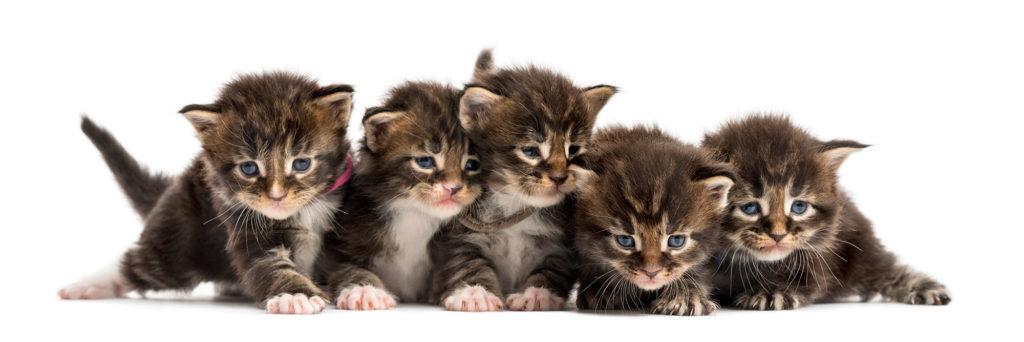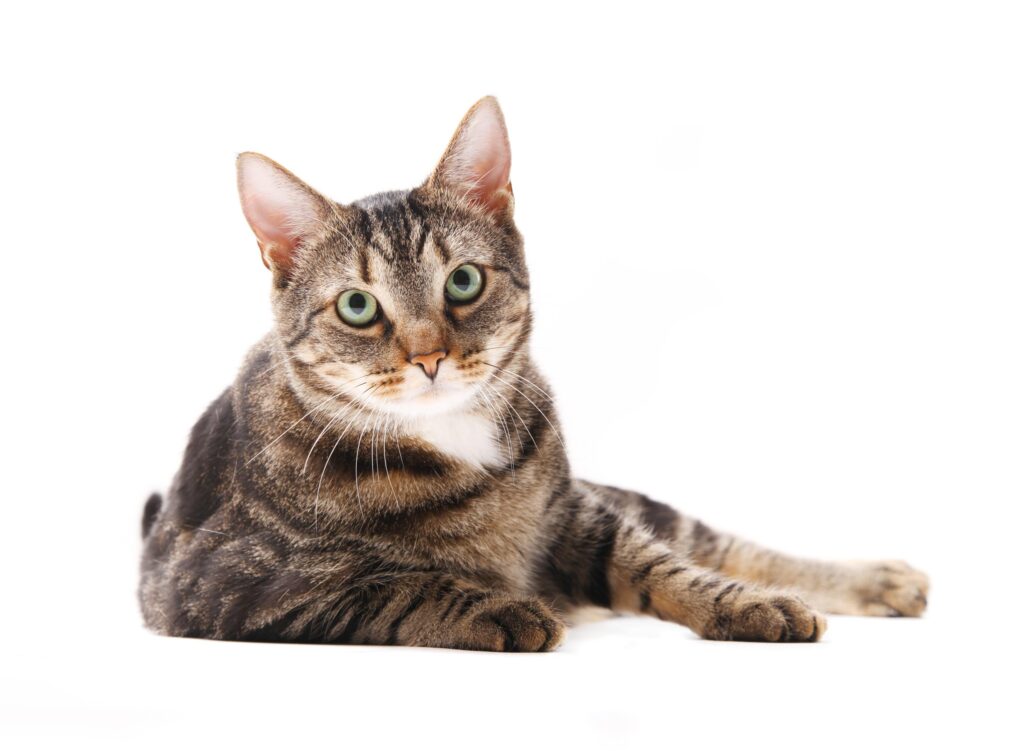Congratulations on your new kitten!
We are eager to meet the newest member of your family so we may welcome him or her into our family.
Wellness Exams:

Your Kitten’s First Wellness Exam
These initial exams include thorough “nose-to-tail” physical evaluations and allow us to establish an individualized wellness care plan for your kitten. The first few visits will allow you to develop a relationship with us, allow our veterinarians to complete your kitten’s vaccination series, test your kitten for feline leukemia and feline FIV and monitor any developing medical or behavioral conditions your kitten may develop.
this wellness exam will include:
- • Comprehensive physical exams
- • Fecal analysis (intestinal parasite screening)
- • Deworming
- • Development of an immunization protocol based on your kitten’s individual needs
- • Vaccinations, depending on your kitten’s age, vaccination schedule and health history
- • Testing for feline leukemia and feline FIV
- • Nutritional counseling
- • Behavior discussion and litter box training recommendations
- • Recommendations for spay, neuter or responsible breeding
- • Description of a lifelong preventive health care plan
- • Recommendations and options for veterinary insurance and wellness plans

Vaccine Protocol for Cats
At Veterinary Medical Center, we follow the vaccine guidelines developed by the American Association of Feline Practitioners (AAFP). The AAFP recommends all cats be vaccinated against the core diseases of rabies and distemper (Feline Viral Rhinotracheitis, Calicivirus, and Panleukopenia). Feline leukemia vaccine is recommended for all kittens (due to their increased susceptibility of infection) and for at-risk cats (cats that go outside unattended, and cats that are exposed to Feline Leukemia positive and untested cats).
Rabies Vaccine
Rabies virus is a fatal infection typically transmitted through bite wounds, open cuts in the skin or onto mucous membranes from the saliva of the infected animal. There is no treatment available once your cat is infected with rabies. This virus has very real and serious human and pet implications. For more information about rabies, visit this link: https://catfriendly.com/feline-diseases/rabies/.
Note: All cats, including indoor cats, are required by Maryland state law to be vaccinated against rabies.
Consider the following:
• There is a small, but real potential for rabies to enter your household. Wildlife such as bats, raccoons or skunks may bring the virus into your house and expose your cat to rabies.
• There is a legal liability should an unvaccinated cat bite or scratch a person. Rabies is a fatal disease for both humans and pets and is found here on the Delmarva Peninsula.
FVRCP (Distemper) Vaccine
The feline FVRCP vaccine is used to protect cats against the three highly contagious viruses: feline herpesvirus, feline calicivirus and feline panleukopenia. The initial kitten series includes vaccine administration every 3-4 weeks with the last vaccine administered after 16 weeks of age. The vaccine is administered again at 1 year of age and then every 3 years.
This vaccine protects against:
Feline Herpesvirus (Feline Rhinotracheitis) – Clinical signs are associated with upper respiratory infection such as sneezing and discharge from the eyes and/or nose. This virus can become latent (inactive) in some cats. These “carrier” cats may have long-term infections that reactivate in times of stress or with treatment that suppresses the immune system.
Feline Calicivirus – Clinical signs include sneezing, eye discharge, nasal discharge, oral ulcers, anorexia, and joint pain (lameness or stiffness.)
Feline Panleukopenia (Feline Distemper Virus) – For more information about panleukopenia, visit this link: https://www.avma.org/public/PetCare/pages/Feline-Panleukopenia.aspx. This virus most commonly attacks the intestine, bone marrow, and brain and can cause severe disease, including death. Symptoms are most severe in kittens. Clinical signs may include severe diarrhea, vomiting, dehydration, fever, lethargy and anorexia. The immune system is often compromised, resulting in secondary infections. This virus is very resistant in the environment and may survive for over a year.
FeLV (Feline Leukemia) Vaccine
After the initial kitten series (2 vaccinations 3-4 weeks apart), it is recommended to booster cats again at 1 year of age, then yearly depending on the risk of exposure to the virus. A FeLV blood test should be performed prior to vaccination.
Feline leukemia is a significant cause of illness and death in cats. The feline leukemia virus is spread through grooming, sharing food or water dishes, or biting. Survival time for cats infected with FeLV ranges from 6 months to 3 years after infection. Clinical signs associated with a viral infection are not specific and may include immune-mediated diseases, tumors, bone marrow disorders including anemia, and secondary infections. For more information on the feline leukemia virus, visit this link: https://catfriendly.com/feline-diseases/felv/.
Vaccine reactions in cats
Vaccine associated sarcomas are rare in cats, and any vaccination or injection poses a risk.
Parasites of cats
Cats are exposed to both internal and external parasites because of their predatory behavior and grooming habits. Visit this link for more information on cat parasitism: https://catfriendly.com/keep-your-cat-healthy/parasite-prevention/.
Heartworm disease in cats is rare, however infection with this parasite can cause serious disease. Cats are not the primary host for heartworms, so adult heartworms may not develop. Most infected cats are asymptomatic, or may develop non-specific symptoms like intermittent vomiting unassociated with eating, or intermittent cough related to asthma type disease. Rarely, cats may present with the severe disease: Heartworm Associated Respiratory Disease (HARD), which is associated with the death of developing juvenile worms. Cats may present with cough, wheezing, and difficulty breathing. If adult worms are present, their death can potentiate HARD signs. Sudden death can occur and is thought to result from a condition similar to acute respiratory distress syndrome in people. For more information about Heartworm disease visit this link: https://catfriendly.com/keep-your-cat-healthy/parasite-prevention/heartworm/.
Intestinal parasites: Cats are prone to intestinal parasitism, with prevalence rates as high as 45 percent; even for indoor cats. These infections may come from other cats, eating raw meat, or ingesting bird/rodent prey. With their fastidious grooming habits, it is easy to ingest a parasite egg or cyst off the fur while licking/grooming. Most cats with infections may have no clinical symptoms and normal stools. Other signs are nonspecific, and may include a dull haircoat, cough, gastro-intestinal upset, poor appetite, or a pot-bellied appearance. Some of these parasites have the potential of infecting humans such as hookworms and roundworms. Common external parasites include fleas, ticks, skin mites, and ear mites. Both indoor and outdoor cats are at risk. In cats, prevention of both heartworm and intestinal parasite infections are done by limiting exposure to vectors spreading the disease, by keeping your cats inside, as well as monthly medication to kill the parasites. We recommend topical Revolution Plus monthly. This medication kills immature heartworm larva, intestinal parasites (roundworms, hookworms, tapeworms) and external parasites such as fleas, ticks, and ear mites. Monthly oral Heartgard for cats is also effective to treat internal parasites, but not external parasites.
Your Kitten’s second Wellness Exam
Feeding Your Cat/Kitten
Shopping for pet food can be overwhelming. Should you buy an organic, natural, or grain free diet, or a diet with no by-products? Many popular brands spend more money on advertising and packaging than on quality ingredients. Other brands use gimmicks to make the food sound more appealing; such as grain-free, all natural, or fresh. What is most important for your pet’s diet is to feed a product that supplies the three essentials: vitamins, minerals and energy supplying nutrients. At VMC we believe pets should eat a good quality food that your pet likes and that suits your budget. A few recommended brands include Purina ProPlan, Hills Science Diet, and Royal Canin.
Cats are obligate carnivores, which mean they have a strict meat- based diet requirement. Some of their diet can include vegetables, which are useful as a source of digestible fiber. Fat in the diet is what makes foods palatable for cats. Most practitioners now support canned food as being the ideal diet for cats. Canned food provides more meat-based protein, less calories than dry food, and has more moisture than dry food. What canned diets don’t provide is the option to feed intermittently during the day. They also lack the convenience of dry food. The exact amount of canned and dry food depends upon your cat’s life stage (kitten, senior), lifestyle (indoor vs. outdoor) and health related needs (weight management). Kittens should be offered canned food daily, with free choice dry food. As kittens mature the quantity of food offered should be reduced.
Be careful of a kibble that contain a lot of dyes or fat, which are often used to either make the product more palatable or appear more interesting to us as pet owners. Be sure the diet names the meat source (for example; chicken, beef, lamb, salmon.) Avoid diets which list meat meal or meat by-products, as the source of this meat is unknown. Chicken meal is essentially the entire chicken ground up into a meal. Chicken by-product meal uses the animal parts not consumed by people. By-products are a less expensive but still a nutritious protein source. Whole grains, fish meal, corn gluten meal, and brewer’s rice are other examples of inexpensive protein sources.
Treats for cats should be limited, as many of them contain sugars and calories. Fresh meats and fish should be limited, as they do not contain essential nutrients cats need daily. Avoid all processed human foods, fatty foods, sweets, and dairy products, as their consumption can lead to serious health issues. For cats who love to eat or tend to gain weight, keep them entertained with interactive toys and feeders.
Any pet food purchased should be AAFCO labeled. The Association of American Feed Control Officials (AAFCO) is defined as a voluntary membership association of local, state and federal agencies charged by law to regulate the sale and distribution of animal feed and animal drug remedies. Essentially, they are the only group in the industry that has established a standard at which you as the consumer will know that your pet food is delivering the nutrients that it is formulated to provide. For more information visit the website www.aafco.org.
Note: AAFCO does not differentiate between the quality of protein sources.
For more tips and information visit these Nutrition Websites and Resources:
• www.purina.com
• www.hillspet.com
• www.royalcanin.com
• American Animal Hospital Association
• American College of Veterinary Nutrition
• An indoor pet environmental enrichment guide
Litterbox Training Cats and Elimination Disorders
Most kittens will naturally use a litterbox to eliminate, provided the box is clean, accessible, and in a quiet place. As they age, some cats develop elimination problems, where they may urinate or defecate outside the box. Some of this behavior is territorial; cats are solitary and will occasionally urinate to mark their territory. Even cats living alone in a house or apartment may urine mark in response to instinct. Other cats develop litterbox aversions, and develop a preference for eliminating on other surfaces (cloth, linoleum, etc.) Urinary tract disorders, painful defecation or fear of interruption can also cause cats to not use the box. Whatever the cause, once a cat begins to avoid the litterbox, it is hard to change the behavior. Luckily there are a few precautions you can take to minimize the chance your kitten will develop these problems.
Rules to Keep Cats Loving the Litterbox
• In multi-cat households, there should be one box/cat, plus one extra. This is an important rule! Many cats do not like to urinate in the same box they defecate in. Others don’t like to eliminate where another cat has gone.
• Avoid scented litter and certain covered or mechanical litterboxes. Cats prefer an open, easily accessible box.
• Avoid putting the litterbox near the food or play station. For bigger homes, be sure the litterbox isn’t in the most distant place in the house, such as the basement or attic.
• Do not use too much litter. Cats don’t like the feeling of too much sand or litter- it is difficult for them to maneuver in. Use just enough litter to cover the bottom, with a bit extra.
• For cats that get agitated with wildlife or other cats outside, keep lower windows covered, so cats cannot see what is going on outside.
• Keep kittens and cats entertained with interactive toys, and climbing and scratching posts.
Get your cat examined by your veterinarian at the first sign of an elimination problem. If there is a medical issue, the sooner the problem can be resolved, the less likely your cat will continue to avoid the box.
Your Kitten’s Third Wellness Exam

COMMON neutering FAQs
What is neutering?
Neutering is a surgical procedure that removes the ovaries and uterus (ovariohysterectomy) or the ovaries (ovariectomy) in the female (commonly known as spaying), and the testicles (castration) in the male. This permanent surgery sterilizes your pet so it cannot reproduce.
Why neuter my pet?
Sterilization of the female eliminates unwanted pregnancy, as well as eliminating heat cycles that occur on average every 6 months. It reduces the risk of mammary cancer that is linked to heat cycles, and it reduces the risk of pyometra (infected uterus).
In the male, it reduces unwanted male behavior, such as urine marking and aggression, as well as roaming. It eliminates the risk of testicular tumors, and also reduces the risk of prostatic infections. It does NOT reduce the risk of prostatic cancer.
When to neuter my pet?
In cats, there is no clear evidence at this time that early neutering is detrimental in any way. We still recommend surgical sterilization at 6 -7 months for both male and female cats.
Will my pet get fat?
Surgical sterilization does not cause your pet to get fat. Diet, exercise, and heredity have much more influence on the weight of your pet. However, because your neutered pet does not have the caloric needs of an unneutered pet, they should be fed less in order to maintain the same weight.
Dental Care
Plaque and tartar accumulate on your pet’s teeth at an early age. This plaque and tartar can lead to gingivitis (infections of the gum). If left untreated, the supporting structures of the tooth will be compromised, leading to tooth decay, pain, and possible bone infection (periodontal disease). Approximately 85% of dogs over three years of age have some degree of periodontal disease. Poor dental health can lead to loss of teeth or accumulation of harmful bacteria, which may cause heart, kidney, and liver disease. The key to preventing dental disease is to start dental care early!
For more information on pet dental care visit: https://www.avma.org/public/PetCare/Pages/Pet-Dental-Care.aspx



